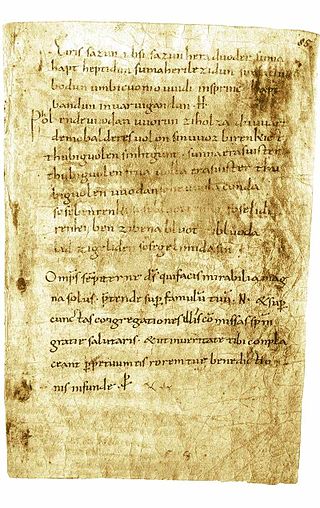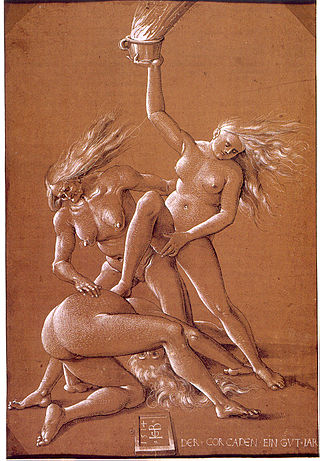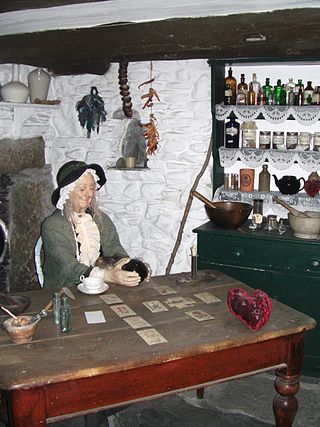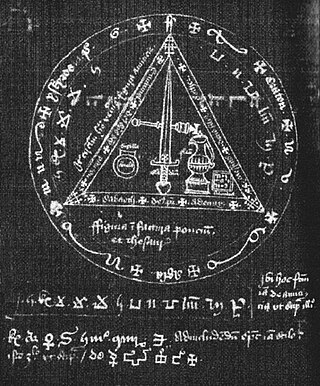Related Research Articles
Witchcraft, as most commonly understood in both historical and present-day communities, is the use of alleged supernatural powers of magic. A witch is a practitioner of witchcraft. Traditionally, "witchcraft" means the use of magic or supernatural powers to inflict harm or misfortune on others, and this remains the most common and widespread meaning. According to Encyclopedia Britannica, "Witchcraft thus defined exists more in the imagination of contemporaries than in any objective reality. Yet this stereotype has a long history and has constituted for many cultures a viable explanation of evil in the world." The belief in witchcraft has been found in a great number of societies worldwide. Anthropologists have applied the English term "witchcraft" to similar beliefs in occult practices in many different cultures, and societies that have adopted the English language have often internalised the term.

Ambarvalia was a Roman agricultural fertility rite held on 29 May in honor of Ceres and Dea Dia.

The Carmen Arvale is the preserved chant of the Arval priests or Fratres Arvales of ancient Rome.
In J. K. Rowling's Harry Potter series, magic is depicted as a supernatural force that can be used to override the usual laws of nature. Many fictional magical creatures exist in the series, while ordinary creatures also sometimes exhibit magical properties. Magical objects are also described. Witches and wizards refer to the rest of the population, who are generally unaware of magic, as "Muggles" in the United Kingdom and "No-Maj" in the United States.

An incantation, a spell, a charm, an enchantment or a bewitchery, is a magical formula intended to trigger a magical effect on a person or objects. The formula can be spoken, sung or chanted. An incantation can also be performed during ceremonial rituals or prayers. In the world of magic, wizards, witches, and fairies allegedly perform incantations.

Filipino witches are the users of black magic and related practices from the Philippines. They include a variety of different kinds of people with differing occupations and cultural connotations which depend on the ethnic group they are associated with. They are completely different from the Western notion of what a witch is, as each ethnic group has their own definition and practices attributed to witches. The curses and other magics of witches are often blocked, countered, cured, or lifted by Filipino shamans associated with the indigenous Philippine folk religions.
A witch's ladder is a practice, in folk magic or witchcraft, that is made from knotted cord or hair, that normally constitutes a spell. Charms are knotted or braided with specific magical intention into the cords. The number of knots and nature of charms varies with the intended effect.

The Merseburg charms or Merseburg incantations are two medieval magic spells, charms or incantations, written in Old High German. They are the only known examples of Germanic pagan belief preserved in the language. They were discovered in 1841 by Georg Waitz, who found them in a theological manuscript from Fulda, written in the 9th century, although there remains some speculation about the date of the charms themselves. The manuscript is stored in the library of the cathedral chapter of Merseburg, hence the name.

A galdr or ġealdor refers to a spell or incantation in Old Norse and Old English respectively; these were usually performed in combination with certain rites.

European witchcraft is a multifaceted historical and cultural phenomenon that unfolded over centuries, leaving a mark on the continent's social, religious, and legal landscapes. The roots of European witchcraft trace back to classical antiquity when concepts of magic and the supernatural were interwoven into societal beliefs. Ancient Rome, then a pagan society, had laws against harmful magic. During the Middle Ages, misogynist views of women led to the association of women and malevolent witchcraft, as accusations of heresy and devil worship grew more prevalent. By the early modern period, major witch hunts began to take place, partly fueled by religious tensions, societal anxieties, and economic upheaval. Witches were viewed as dangerous sorceresses or sorcerers in a pact with the Devil, capable of causing harm through black magic.

In classical antiquity, including the Hellenistic world of ancient Greece and ancient Rome, historians and archaeologists view the public and private rituals associated with religion as part of everyday life. Examples of this phenomenon are found in the various state and cult temples, Jewish synagogues, and churches. These were important hubs for ancient peoples, representing a connection between the heavenly realms and the earthly planes. This context of magic has become an academic study, especially in the last twenty years.
Segen is a German word translating to "blessing, benediction; charm; prayer; spell, incantation".

In ancient Roman religion and magic, the fascinus or fascinum was the embodiment of the divine phallus. The word can refer to phallus effigies and amulets, and to the spells used to invoke his divine protection. Pliny calls it a medicus invidiae, a "doctor" or remedy for envy or the evil eye.
The Medicina Plinii or Medical Pliny is an anonymous Latin compilation of medical remedies dating to the early 4th century AD. The excerptor, saying that he speaks from experience, offers the work as a compact resource for travelers in dealing with hucksters who sell worthless drugs at exorbitant prices or with know-nothings only interested in profit. The material is presented in three books in the conventional order a capite ad calcem, the first dealing with treatments pertaining to the head and throat, the second the torso and lower extremities, and the third systemic ailments, skin diseases, and poisons.

Khatha, or "Gatha", as originally called in Pali Language), is the Khmer and Thai name used for Sacred Pali prayers, mantras and other magical incantations. Khatha are used in general by Thai people for a great many purposes; be it for protection, charm or business ventures, there is a Khatha which can be summoned. The word Khatha, or "Gatha" in Pali, means "Speech", and thus the original meaning of the word implies that Khatha were used only as spoken language, and not written form. In spite of this fact, the word Khatha is used to refer to both that which is spoken, and also written.

Cunning folk, also known as folk healers or wise folk, were practitioners of folk medicine, helpful folk magic and divination in Europe from the Middle Ages until the 20th century. Their practices were known as the cunning craft. Their services also included thwarting witchcraft. Although some cunning folk were denounced as witches themselves, they made up a minority of those accused, and the common people generally made a distinction between the two. The name 'cunning folk' originally referred to folk-healers and magic-workers in Britain, but the name is now applied as an umbrella term for similar people in other parts of Europe.
In Bavarian folklore of the Early Modern period, a Wolfssegen was an apotropaic charm against wolves; conversely, a Wolfbann (Wolf-Bann) was a malevolent spell causing a wolf attack.

During the Middle Ages, magic took on many forms. Instead of being able to identify one type of magic user, there were many who practiced several types of magic in these times, including monks, priests, physicians, surgeons, midwives, folk healers, and diviners. The practice of “magic” often consisted of using medicinal herbs for healing purposes. Classical medicine entailed magical elements. They would use charms or potions in hopes of driving out a sickness. People had strongly differing opinions as to what magic was, and because of this, it is important to understand all aspects of magic at this time.

Gaius Furius Chresimus, or Cresimus, or Cressinus, was a 2nd-century BC Greek farmer and freedman in the Roman Republic mentioned in a fragment of the lost history of Lucius Calpurnius Piso Frugi, preserved in Pliny's Natural History. Piso tells that Furius Chresimus was acquitted of accusations of witchcraft during the aedileship of Spurius Postumius Albinus, dated 191 BC. The trial took place in a period of reaction against the growing influence of Hellenism at Rome, notably led by Albinus. Both Piso and Pliny told the story of the trial for its moralizing aspect.
Tibullus book 1 is the first of two books of poems by the Roman poet Tibullus. It contains ten poems written in Latin elegiac couplets, and is thought to have been published about 27 or 26 BC.
References
- ↑
 This article incorporates text from a publication now in the public domain : Chambers, Ephraim, ed. (1728). "Carmen". Cyclopædia, or an Universal Dictionary of Arts and Sciences (1st ed.). James and John Knapton, et al.
This article incorporates text from a publication now in the public domain : Chambers, Ephraim, ed. (1728). "Carmen". Cyclopædia, or an Universal Dictionary of Arts and Sciences (1st ed.). James and John Knapton, et al. - ↑ Lewis, C. T. & Short, C. 1879, A Latin Dictionary, New York: Harper and Brothers; see the entry under carmen.
- ↑ "Charm | Origin and meaning of charm by Online Etymology Dictionary".
- 1 2 3 4 Burriss, Eli Edward. Taboo, Magic, Spirits: A Study of Primitive Elements in Roman Religion . New York, Macmillan Company. 1931. Public domain.
- ↑ "Pliny the Elder, the Natural History, BOOK XVIII. THE NATURAL HISTORY OF GRAIN., CHAP. 8.—MAXIMS OF THE ANCIENTS ON AGRICULTURE".